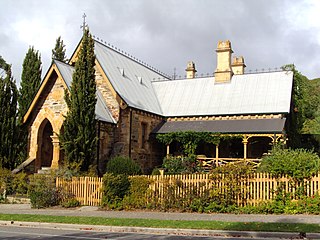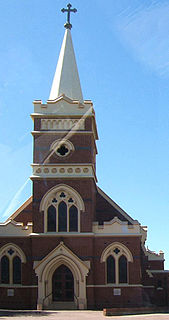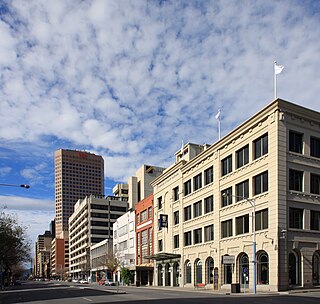
North Terrace is one of the four terraces that bound the central business and residential district of Adelaide, the capital city of South Australia. It runs east–west, along the northern edge of "the square mile". The western end continues on to Port Road, and the eastern end continues across the Adelaide Parklands as Botanic Road.

Clarendon is a small town in the Adelaide Hills, about 25–30 kilometres (16–19 mi) south of the Adelaide city centre and now regarded as an outer suburb of Adelaide. It lies within the City of Onkaparinga council area. The Clarendon Weir is located in the town area, on the Onkaparinga River.

Torrensville is a western suburb 3 km (1.9 mi) west of the centre of Adelaide, South Australia. It was named after Irish-born economist and chairman of the South Australian Colonisation Commission, Robert Torrens.

Morphett Vale is a southern suburb of Adelaide, South Australia in the City of Onkaparinga. It is the largest suburb in the state, with a population of more than 23,000 and an area of 12.76 km², followed by Paralowie with nearly 10,000 fewer residents. There are approximately 1,000 businesses in Morphett Vale. The suburb is bordered by Sheriffs/Pimpala Road, Panalatinga Road, Doctors/Beach Road, and the Southern Expressway.

Thebarton, formerly Theberton, on Kaurna land, is an inner-western suburb of Adelaide, South Australia in the City of West Torrens. The suburb is bounded by the River Torrens to the north, Port Road and Bonython Park to the east, Kintore Street to the south, and South Road to the west.

Adelaide Festival Centre, Australia's first multi-purpose arts centre and the home of South Australia's performing arts, was built in the 1970s, designed by Hassell Architects. The Festival Theatre opened in June 1973 with the rest of the centre following soon afterwards. The complex includes Festival Theatre, Dunstan Playhouse, Space Theatre and several gallery and function spaces. Located approximately 50 metres (160 ft) north of the corner of North Terrace and King William Road, lying near the banks of the River Torrens and adjacent to Elder Park, it is distinguished by its two white geometric dome roofs, and lies on a 45-degree angle to the city's grid.

A coffee palace was an often large and elaborate residential hotel that did not serve alcohol, most of which were built in Australia in the late 19th century.

Adelaide city centre is the inner city locality of Greater Adelaide, the capital city of South Australia. It is known by locals simply as "The City" or "Town" to distinguish it from Greater Adelaide and from the City of Adelaide local government area. The population is 15,115.

The South Australian Brewing Company, Limited is a brewery located in Thebarton, an inner-west suburb of Adelaide, South Australia. It is a subsidiary of Lion, which in turn is owned by Kirin, a Japan-based beverage company. It manufactures West End Draught beer.

Morphett Street is a main street in the west of the city centre of Adelaide, South Australia, parallel to King William Street and numbered from north to south. At its northern end it is part of the West End of Adelaide, a thriving cultural and entertainment precinct, with the Lion Arts Centre on the south-western corner of its junction with North Terrace.

Dr Charles George Everard MD was a physician, pioneer farmer and Member of the Legislative Council, in the early days of South Australia.

Currie Street is a main street in the Adelaide city centre, South Australia. It runs east–to–west from King William Street, through Light Square, to West Terrace on the western edge of the city centre.

The Queen's Theatre is a building of historic importance in Playhouse Lane, Adelaide, South Australia. It is the oldest intact theatre in mainland Australia, having originally been built in 1840, the only earlier one in Australia being the still-operational Theatre Royal in Hobart, Tasmania. It was not the first theatre to open in Adelaide however; there were two earlier, less sophisticated earlier venues created in 1838–9.
Cawthorne and Co, also known as Cawthorne's Limited, was a company founded in 1870 in Adelaide, South Australia, by Charles Cawthorne and his father William Anderson Cawthorne, which dealt in musical instruments, sheet music and recordings, and acted as concert promoters.

The Adelaide Glaciarium, located in Adelaide, South Australia, was the first indoor ice-skating facility built in Australia. It is also the location of the first "hockey on the ice" match in the country, which was an adaptation of roller polo for the ice using ice skates. Contemporary ice hockey was never played at this venue but this ice skating rink, the country's first, provided the "test bed" facility for its successor, the Melbourne Glaciarium, the birthplace of ice hockey in Australia.
The Theatre Royal on Hindley Street, Adelaide was a significant venue in the history of the stage in South Australia.
The West End Brewery in Hindley Street, Adelaide, was a South Australian brewer of beer founded in the colony of South Australia in 1859 by a consortium of brewers. Its West End Ale was a popular brand and the enterprise was a successful one. The company merged with the Kent Town Brewery and Ben Rounsevell's wine and spirit business to create the South Australian Brewing, Malting, Wine and Spirit Company, in 1888, which continued to use the West End brand.
William Henry Clark (c.1815–1870) was an early settler and brewer in Adelaide, in the Colony of South Australia. He was the founder of the Halifax Street Brewery around 1844, and in 1859 was responsible for the building of a brewery at the western end of Hindley Street. However he fell into insolvency, leaving the state in 1860 to avoid his debtors, and the Hindley Street brewery taken over by William Knox Simms, later becoming the West End Brewery.
The Hindmarsh Brewery was a brewery founded c.1844 in Hindmarsh, in the then colony of South Australia, by E. J. F. "Fred" Crawford. Crawford lost possession of the business in 1859, then re-established it on a different site before becoming bankrupt. It was then taken over by Henry Haussen and George Catchlove, and was successfully operated by them and their successors until 1927.
The Pirie Street Brewery was a brewery situated on Pirie Street and Wyatt Streets, Adelaide, in the early days of the British colony of South Australia. It was succeeded on the same site after a few years by the Adelaide Brewery. Its original address was 50-62 Wyatt Street; today the buildings at 54–60 are heritage-listed in the South Australian Heritage Register, and there is a remaining building at 113 Pirie Street now occupied by the Hill Smith Gallery.


























